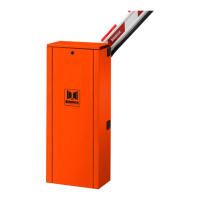22
6) MANUAL AND EMERGENCY MANOEUVRES
In the event of a power cut or of abnormal operation, it is possible to release the bar and move it by hand (Fig. 6).
Using the key provided:
• To release the bar, turn the key in a clockwise direction until you fell a certain resistance.
• To restore the automatic movement of the bar, turn the key in an anti-clockwise direction until it is blocked.
7) BALANCING (FIG. 7)
For good operation of the barrier it is fundamental for the bar to be suitably balanced by the action of the spring. To check this, proceed as follows:
• Ensure that the spring is fixed to the correct point of the lever (see paragraph 2).
• Mechanically release the barrier using the release key.
• The correctly balanced bar must stay still in whichever point it is positioned:
- if it tends to open, decrease the tension of the spring
- if it tends to close, increase the tension of the spring
The tension of the spring may be regulated by manually screwing (anti-clockwise rotation) or unscrewing (clockwise rotation) the spring itself. Once
you have regulated the spring tension, block it, screwing down the nut “D” until it makes contact with the cap T.
8) REGULATING THE MECHANICAL STOPS (FIG.8)
The inertial movement of the bar after the motor stops is blocked using the adjustable mechanical stops shown in Fig.8.
After having regulated the opening/closing limit stop cam, bring the respective closing mechanical stop into contact with the lever. The opening mechani-
cal stop is of the damped type.
With reference to Fig.8:
• Slacken the blocking dowel
• Tighten /unscrew the mechanical stop until the desired position of intervention is obtained
• Tighten the blocking dowel
9) WIRE DIAGRAM (FIG.11)
1 Control unit CP.EVA2
2 Transmitting photocell FTC
3 Receiving photocell FTC
4 Blinking lights LADY.L
5 Photocell column for barrier LADY.COL
6 Bottom/top rubber protection LADY.P
7 Resistive edge SC.RES
8 Mod. VE.AF / VE.AFI accessory
10) CP.EVA2 CONTROL UNIT WIRE DIAGRAM
Wire connections shown in Fig. 12 are described hereunder:
SA.24V
TERMINALS Function Description
L-N-GND Power supply Mains input 100÷250Vac 50/60Hz
+ - Output 24Vdc Controller CP.1524 power supply output 24 Vdc
BAT-BAT Batteries Clamp input for connection of back-up batteries (accessory).
CP.EVA2
TERMINAL BLOCK M1
M1 24Vdc INPUT
24Vdc input for powering the CP.EVA2.In case of use of the SUN SYSTEM it is necessary to connect
the 24Vdc output of the SUN.SY to M1 (see the KSUN instructions)
TERMINAL BLOCK M2
P.P. Step by step Input for step by step command (N.O. contact) .
CLOSE Close Input for close command (N.O. contact) .
OPEN Open Input for open command (N.O. contact), It is possible to connect a timer for programmed openings.
PHOT Photocell Input for photocells enabled during opening and closing phase (N.C. contact).
STOP STOP Input for STOP command (N.C. contact).
SWC Closing limit switch
Input for closing limit switch (N.C. contact).
To be used ONLY FOR BARRIER WITH ELECTROMECHANICAL LIMIT SWITCHES. If not used it is NOT
NECESSARY TO BRIDGE the input to the common COM.
SWO Opening limit switch
Input for opening limit switch (N.C. contact).
To be used ONLY FOR BARRIER WITH ELECTROMECHANICAL LIMIT SWITCHES. If not used it is NOT
NECESSARY TO BRIDGE the input to the common COM.
COM Common Common for all the input commands and the limit switches .
AUX2 24Vdc output for bar light
24Vdc output for the bar flashing light EVA.L (max 2), the flashing mode can be set by means of the
logic LBAR.
BLINK Blinker
Output 24Vdc 15W max. for flashing light connection (EVA.LAMP) to be installed on the top cover of
the barrier.

